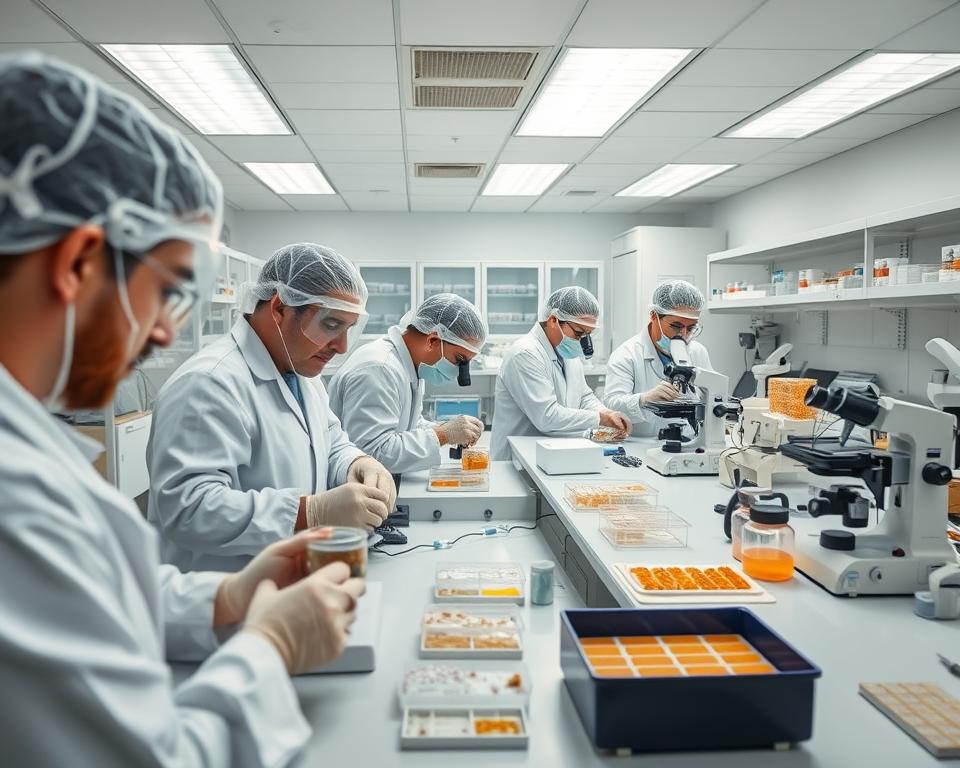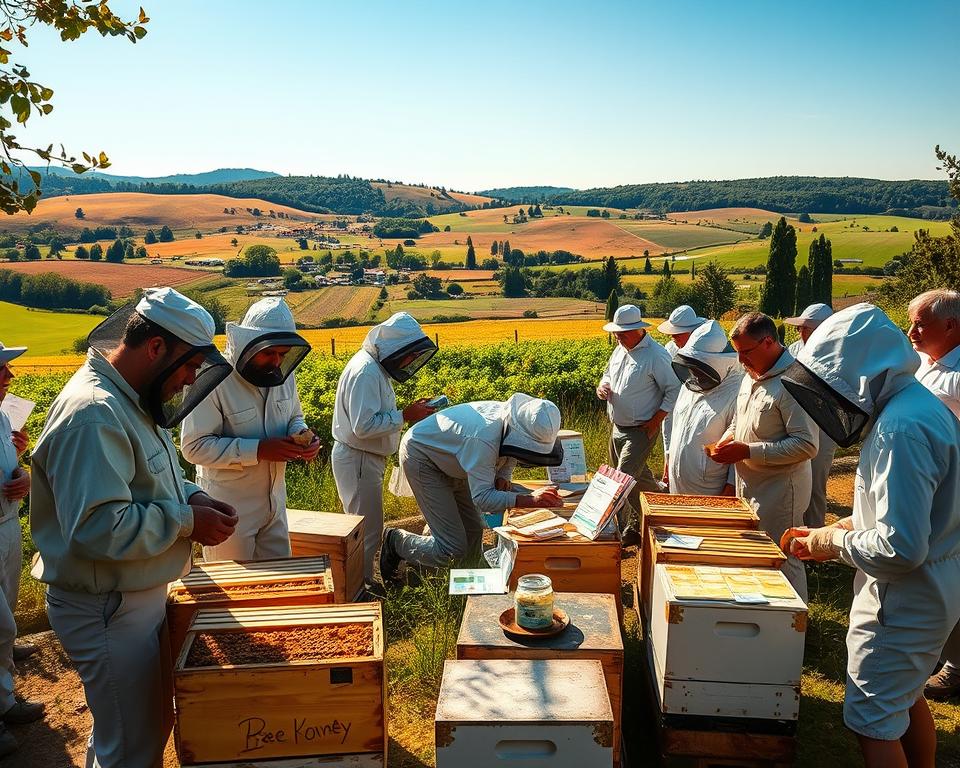As a beekeeper, I’ve learned that keeping a healthy beehive is key. Did you know that a single diseased hive can threaten the health of surrounding colonies, making honeybee health a top priority?
Effective apiary management strategies are vital for stopping disease and pest spread. By using best practices and staying updated, I protect my hive’s health. For more info, I check out protecting your bees from diseases and.
Key Takeaways
- Regular hive inspections are key for early disease and pest detection.
- Keeping a clean and strong hive is vital for honeybee health.
- Using best beekeeping practices can stop disease spread.
- Telling local authorities about suspected pests or diseases is important.
- Knowing about apiary management strategies helps keep your hive safe.
Understanding Common Bee Diseases
As a beekeeper, it’s key to know about common diseases in honeybees. These diseases can harm the health of the colony. If not treated, they can cause the colony to fail.
Bees can get sick from Varroa mites, Nosema, and American Foulbrood. These sicknesses can lead to less honey and even the loss of the colony.
Varroa Mites: The Silent Threat
Varroa mites are a big problem for honeybee colonies. They suck the life out of bees, weakening their immune system. This makes bees more likely to get sick.
To fight Varroa mites, beekeepers use integrated pest management and chemicals. It’s important to check the colony often to catch mites early.
Nosema: What You Need to Know
Nosema is a fungus that messes with a bee’s stomach. It can make bees sick and shorten their lives.
To keep Nosema away, bees need clean water and food. Keeping the hive clean also helps prevent Nosema.
American Foulbrood: Signs and Symptoms
American Foulbrood (AFB) is a bacterial disease that hits honeybee larvae hard. It spreads fast and can destroy a colony if not stopped.
AFB shows up as a spotty brood pattern. Some cells have dead or sick larvae. If you see this, act fast to save your colony.
Knowing about these diseases helps beekeepers keep their colonies healthy. Regular checks and clean hives are key to stopping disease. This keeps the colony strong.
Importance of Regular Hive Inspections
Regular hive inspections are key to keeping bees healthy. By checking my hive often, I can spot problems early. This keeps my bees healthy and my hive strong.
How to Conduct a Hive Inspection
Inspecting a hive needs careful steps. First, I wear protective clothes to avoid getting stung. Then, I smoke the bees to calm them down.
Next, I take out the frames one by one. I look for any signs of disease or pests. It’s important to be very careful during this step.
Identifying Potencial Health Issues
Spotting health problems in a hive requires knowing what to look for. I check for unusual smells, color changes, or odd bee behavior. For example, a bad smell might mean American foulbrood, a serious disease.
“The key to maintaining healthy bees is regular inspection and swift action when problems are detected.”
Frequency of Inspections: Best Practices
How often to inspect a hive depends on the season and my apiary’s conditions. In busy seasons, I check every 7-10 days. In quieter times, I do it less often but keep up the habit.
| Inspection Frequency | Season | Reason |
|---|---|---|
| Every 7-10 days | Peak season | Monitor for pests and diseases |
| Every 4-6 weeks | Off-season | Check for overall health |
By sticking to these guidelines, I keep my bees healthy. This helps me manage my apiary well.
Role of Nutrition in Bee Health
As a beekeeper, I’ve learned that nutrition is key to my bees’ health. A well-fed bee colony can fight off diseases and handle stress better. This helps keep honeybee health and bee population sustainability strong.
Essential Nutrients for Bees
Bees need a balanced diet with carbs, proteins, and other nutrients. Carbs from nectar give them energy. Proteins from pollen help them grow and raise young. Vitamins and minerals are also vital for their health.
Bees need a varied diet to get all these nutrients. This means they should have access to different flowers. Key nutrients include:
- Nectar: rich in carbohydrates, providing energy for bees
- Pollen: high in proteins, essential for brood rearing
- Vitamins and minerals: critical for health and immune function
Sources of Quality Bee Feed
It’s important to give my bees the best food. Bees forage for nectar and pollen naturally. But, they might need extra food sometimes, like when there’s not enough to eat or when starting a new colony.
Good sources of food for bees include:
- Sugar syrup: a carb source to supplement nectar
- Pollen supplements: boost protein intake
- Pollinator-friendly plants: flowers that give nectar and pollen
Avoiding Nutritional Deficiencies
Nutritional deficiencies can harm bees a lot. Signs include fewer baby bees, slow growth, and more sickness. It’s important to spot and fix these issues.
To prevent nutritional problems, I:
- Keep an eye on my bees’ health and growth
- Make sure they eat a variety of foods from different flowers
- Use high-quality food when they need it
By focusing on nutrition, I help my bees stay healthy. This supports hive health practices and helps my bee population stay strong.
Best Practices for Hive Management
As a beekeeper, I know how vital it is to manage hives well. This keeps my bees healthy. Good management stops diseases and keeps the hive thriving.
Seasonal Management Tips
Seasons change, and so does how we manage hives. In spring, I check my hives often for diseases and pests. A wise beekeeper once told me, “Regular checks are key to spotting problems early.”
In summer, I make sure hives have good airflow to avoid heat stress. In fall, I stock up food and protect hives from cold. Winter means keeping a close eye on my hives for any signs of trouble.
Keeping Hives Clean and Organized
Keeping hives clean and tidy is a must for bee health. I clean out debris and old comb regularly. Good maintenance stops disease and keeps bees healthy.
I also make sure hives are organized. Frames are aligned and secure. This reduces stress on the bees and keeps them healthy.
Monitoring Bee Behavior
Watching how bees behave is key to spotting issues early. I observe my bees often for signs of disease or pests. Behavior changes can signal a problem, and acting fast can prevent it from getting worse.
By following these best practices, I help my bees stay healthy. Good apiary management, disease prevention, and protecting pollinators are all important for beekeeping success.
Natural Remedies for Disease Prevention
Using natural remedies is a great way to stop bee diseases. As a beekeeper, I keep my bees healthy. Natural methods are key to this.
Essential Oils in Bee Health
Essential oils are popular among beekeepers. They help manage diseases. For example, thyme oil fights Varroa mite infestations.
It’s important to use essential oils right to protect the bees. You can use diffusers or mix with sugar. Always watch how the bees react to new treatments.
Herbal Solutions for Hive Care
Herbs are another natural way to keep bees healthy. Some herbs fight off diseases. This keeps the hive healthy.
Benefits of Herbal Solutions:
- Promote a healthy environment within the hive
- Support bee immune systems
- Can be used in various forms, such as teas or infusions
| Herb | Benefit | Application Method |
|---|---|---|
| Echinacea | Boosts bee immune system | Infusion for feeding |
| Garlic | Repels pests | Mixed with sugar for feeding |
| Calendula | Antimicrobial properties | Used in hive cleaning solutions |
Using natural remedies helps my bees stay healthy. It’s a smart way to keep my apiary thriving. It works well with good beekeeping practices.
Chemical Treatments: An Overview
Natural remedies are often preferred, but sometimes chemical treatments are needed to keep bees healthy. As a beekeeper, knowing how to use chemical treatments for colony disease control is key.

Chemical treatments can help keep bee populations sustainable. But, using them requires careful thought to avoid harming bees or contaminating honey and wax.
When to Use Chemical Treatments
Chemical treatments are used when a disease threatens the hive. For example, if Varroa mites or American Foulbrood bacteria are present, treatment is needed. It’s important to follow guidelines from trusted sources to use treatments correctly.
Safe Application Methods
Applying chemical treatments safely means knowing the right dosage and timing. This includes using bee disease medications or integrated pest management. Always read the product instructions and protect yourself and the bees.
Understanding Resistance
Chemical treatments can lead to pests and diseases becoming resistant. To fight this, rotate treatments and use a mix of apiary management strategies. This includes monitoring for disease, keeping hives clean, and ensuring bees eat well. Diversifying your approach helps keep treatments effective.
In summary, chemical treatments are vital for apiary management strategies. They help control diseases and keep bees healthy. By knowing when and how to use them, you can protect your bees and support bee population sustainability.
The Importance of Genetic Diversity
Genetic diversity is key to a healthy beehive. It helps bees fight off diseases and pests. As a beekeeper, it’s vital to keep my bees genetically diverse for their health and survival.
Keeping a diverse hive lowers disease risks and boosts bee productivity. I achieve this by choosing and breeding queens from various genetic lines.
Benefits of Diverse Breeding
Diverse breeding has many advantages. It improves disease resistance, boosts honey production, and helps bees adapt to environmental changes. By mixing different genetic backgrounds, I create a stronger, more resilient bee population.
The main benefits of diverse breeding are:
| Benefit | Description |
|---|---|
| Disease Resistance | Genetic diversity helps bees fight diseases better. |
| Honey Production | Diverse breeding leads to more honey due to healthier bees. |
| Environmental Adaptability | Genetically diverse bees adapt better to environmental changes. |
How to Select Healthy Queens
Choosing healthy queens is essential for genetic diversity. I look for signs of health like strong pheromones, active egg-laying, and overall energy.
To pick the best queens, I follow these steps:
- Watch the queen’s behavior and health.
- Check for disease or parasites.
- Look at the queen’s egg-laying patterns.
- Consider the queen’s genetic background.
By picking healthy queens and promoting diversity, I keep my beehive healthy and sustainable.
Creating a Healthy Environment
The health of my bees depends on their living environment. As a beekeeper, I know a clean space is key for their well-being.
Optimal Locations for Hives
Finding the perfect spot for my beehives is vital. I look for places with adequate sunlight and good air circulation. These conditions help prevent disease and keep bees active.
I also steer clear of areas with standing water or where water tends to collect. Such spots can attract pests and diseases. A spot with good drainage helps keep my bees healthy.
Minimizing Pesticide Exposure
Pesticides harm bee colonies, so I reduce their exposure. I avoid areas with lots of pesticides and use natural or integrated pest management methods instead.
Being careful about the environment and taking action helps lower pesticide risks for my bees.
Enhancing Biodiversity Around Hives
Boosting biodiversity around my hives is another important step. By planting a variety of flowers and herbs, I give my bees many food options.
This not only keeps my bees healthy but also helps protect insect pollinators. By supporting biodiversity, I help my bee colonies thrive and prevent bee virus prevention by keeping the ecosystem balanced.
Collaboration with Local Beekeeping Associations
Working with other beekeepers through local groups has really helped me with beekeeping disease prevention. We share knowledge and best practices to keep our bees healthy.
Membership Benefits
Being part of a local beekeeping association has many perks. You get expert advice, workshops, and chances to meet other beekeepers. Some key benefits are:
- Staying updated on the latest apiary management strategies
- Learning from seasoned beekeepers who’ve managed diseases well
- Joining in on group buys for equipment and supplies, saving money

Resources and Support
Local beekeeping groups offer lots of resources. You can find libraries, equipment to borrow, and mentors. These are great for both new and seasoned beekeepers wanting to get better at apiarist disease management.
Community Education
Teaching the community about bees is key for beekeeping groups. By educating people, we help create a friendlier place for bees. This includes:
- Hosting workshops and seminars on bee health
- Joining local events to spread the word about beekeeping
- Working with schools to add beekeeping and environmental lessons
By teaming up with local beekeeping groups, I help build a stronger beekeeping community. This benefits both beekeepers and the environment.
Keeping Records for Better Hive Management
Keeping accurate records is key to successful beekeeping. By tracking hive health, I can spot trends and make smart choices. This helps keep my apiary strong.
Types of Records to Maintain
To manage my hives well, I keep different kinds of records. These include:
- Inspection records: noting the condition of the hive, presence of diseases, and queen activity
- Honey harvest records: tracking the amount of honey harvested and the condition of the honey supers
- Treatment records: documenting any treatments or medications administered to the bees
- Weather and climate records: observing how weather patterns affect bee behavior and hive health
Keeping these records helps me spot patterns. This way, I can make better decisions to improve hive health practices and bee population sustainability.
Using Technology in Record-Keeping
Today, there are many digital tools to help with record-keeping. I use beekeeping apps, spreadsheets, or software to track my hive data. These tools let me:
- Access my records from anywhere, at any time
- Generate reports and graphs to visualize trends
- Set reminders for regular inspections and treatments
Using technology in my record-keeping makes managing my apiary management strategies easier. It helps me keep my beehives healthy and thriving.
Understanding the Role of Pollinators in Agriculture
The health of our farms depends a lot on pollinators. Their role is not just helpful but vital for growing crops.
Pollinators like bees, butterflies, and other insects help many plants reproduce. Healthy bees are key for pollinating crops like fruits, veggies, and nuts. Without them, many crops would have lower yields and quality.
How Healthy Bees Support Crop Production
Healthy bees are the heart of many farms. They help pollinate, which is key for many crops. The health of bee colonies affects how well crops grow and taste. A healthy colony can pollinate more and better, leading to more fruit and higher yields.
“The value of pollinators, like bees, is huge. They’re a key part of our farming world, and their health is linked to our food supply.”
The Economic Impact of Bee Health
The economic side of bee health is big. A sick bee can mean lower crops, worse produce, and more costs for farmers. This can raise food prices and affect the economy. Studies say bees add tens of billions of dollars a year to the US economy.
To keep pollinators safe and stop bee viruses, we need to follow best practices. This means taking care of bees and making places friendly for them. We should plant a variety of flowers that bees love.
By understanding pollinators’ role in farming and protecting them, we can make farming better and more sustainable.
Resources for Further Learning
I’m always looking to learn more about beekeeping disease prevention and managing diseases in apiaries. To stay current, I use many resources. They give me valuable insights and practical tips.
Practical Guides and Literature
Books and guides are a great place to start. They dive deep into beekeeping best practices, including how to prevent and manage diseases. Some books have become key in my beekeeping journey. They help me keep my bees healthy.
Online Education and Community Events
Online courses and webinars are also key. They let me learn from experts in beekeeping and disease management. Local workshops and events are great for meeting other beekeepers. We share knowledge and experiences that improve our beekeeping skills.
